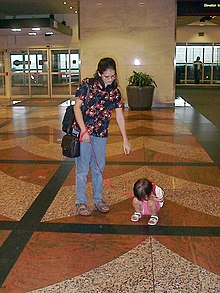Child safety belt
A child safety belt , also known colloquially as a child's reins or leash , is a safety harness for children that is intended to ensure child safety in everyday life. Also Kinderlaufgurt or Kindergeschirr occur as names. It is a restraint system that is either connected to a child care item (e.g. high chair ) or used by means of retaining reins when the child is walking or learning to walk.
Typical manifestations are belts over the chest and shoulder with retaining reins attached in the middle or on the side, wrist reins, and backpacks with rear retaining reins.
standardization
In the European Union , child safety belts and reins must meet the standards and safety requirements of EN 13210: 2004. The standard is to be applied to belt and restraint systems for the restraint of children up to 4 years of age , in particular chest straps and wrist reins for fixing at attachment points of articles for small children and with removable retaining reins for use when walking. The standard does not apply to restraint systems that are an integral part of articles for infants and young children; intended for children with special needs; and which are to be used in motorized vehicles.
General requirements
The standard relates to the general product safety of toys with regard to the mechanical and physical properties, sharp edges and protruding corners, small parts, and the migration of dangerous substances such as heavy metals or nickel.
The standard requires a minimum width of all straps and straps of 20 mm, defines the minimum adjustment ranges of shoulder and lap straps as well as wrist loops, depending on the suitability of the product for children from birth or from the age of 6 months . Maximum adjustment ranges are not specified for the straps, except for the retaining reins, which must not be longer than 1200 mm.
The holding rein is called a guide rein when it is attached to a single point on the lap belt, and a walker rein when it is attached to both sides of the lap belt.
Strength test
No adjustment device may show more slippage than 20 mm if it has been loaded 10 times with a tensile force of 100 N.
For the dynamic strength test, the chest strap type is pulled over a test body (test dummy), which consists of a sack (300 mm × 470 mm) and was filled with dry, compacted sand. The test body is hung on a frame. The hanging rein is simply hung in the frame with the wrist loops closed.
In all tests, the belt is statically preloaded with a test mass of 20 kg, which is attached to the rein attached to the intended attachment point (s) of the belt. The connection to the test mass is made with a helical spring ( spring constant 28000 N / m). In the system of the 20 kg test mass there is a dynamic test mass of 13 kg, which is movably attached and can fall 300 mm, so that a dynamic balance is created.
The dynamic test requires the dynamic test mass to be triggered 5 times in a time window of 5 minutes, each time with a fall of 300 mm. The belt including its seams, rivets and connecting elements must not be damaged afterwards and must continue to function as intended.
Markings and instructions
The belt must have permanent markings that refer to this standard and the year of publication (EN 13210: 2004), allow identification of the manufacturer or dealer and the product, as well as describe cleaning. Instructions must u. a. contain specific warnings about dangerous situations, indicate the intended age range of the child, contain instructions for dressing and fitting, indicate signs of wear and damage. They must contain the instruction not to leave a harnessed child unattended.
Further development of the standard
A new version of the standard is in preparation (current draft prEN 13210: 2019-04). Part -1 will focus on safety harnesses and reins , while part -2 will deal with safety harnesses including backpacks and reins .
controversy
Proponents argue that a child safety belt gives a child more freedom of movement than holding them by the hand or in a stroller . Critics believe that children are led like animals (compare dog leash ).
See also
- Gangelband on the historical context
- Child seat for belting in motor vehicles and bicycles
- Strapping in strollers
Individual evidence
- ↑ a b Paddy Bauer: Is it allowed to keep children on a leash? , The daily newspaper of September 28, 2014, accessed on August 11, 2019.
- ↑ a b DIN EN 13210: 2004 Articles for infants and young children - Safety harnesses , reins and similar articles for children - Safety requirements and test methods; Beuth-Verlag, Berlin, 2004 German version EN 13210: 2004
- ↑ DIN EN 13210-2: 2019-04 - Draft articles for infants and young children - Part 2: Safety harnesses including rucksacks and reins - Safety requirements and test methods; Beuth-Verlag, Berlin, 2019
